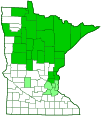showy mountain-ash
(Sorbus decora)
Conservation • Wetland • Description • Habitat • Ecology • Use • Distribution • Taxonomy
Description |
Showy mountain-ash is a native deciduous shrub or tree of northeastern North America. It occurs in the United States from Maine to Pennsylvania, west to Minnesota and northern Illinois. It occurs in southern Canada from Nova Scotia to Saskatchewan. In Minnesota it is common along the North Shore but occasional or infrequent elsewhere. Showy mountain-ash is found in forest margins, thickets, wooded dunes and bluffs, rocky slopes, rock outcrops, cliffs, lake shores, and stream sides. It grows in moist to dry soil. Showy mountain-ash is a very small tree or a tall shrub with 2 to 4 stems. The stems can be 10′ to 49′ (3 to 15 m) in height and up to 15¾″ (40 cm) in diameter at breast height (dbh), but in Minnesota they rarely get over 32′ (10 m) tall and 11¾″ (30 cm) in diameter. The bark on young stems is smooth and silvery gray to grayish brown with numerous conspicuous pores (lenticels). The lenticels are horizontal, and their borders protrude from the bark. On older stems the bark cracks, especially near the bottom, it develops plate-like scales, and eventually it peels. The lenticels remain prominent on older stems. First-year twigs are greenish to brownish and hairless or almost hairless. Second-year twigs are stout, reddish brown, and hairless. The terminal bud is conspicuous and large. It is egg shaped to cone shaped, pointed, and ⅜″ to ½″ (10 to 12 mm) long. The scales are shiny and hairless except for a fringe of short hairs on the margins at and near the tip. The leaves are alternate, stalked, and pinnately divided (compound) into 11 to 17 leaflets. The leaflets are opposite, 1¾″ to 3″ (4.5 to 8.0 cm) long, and ⅝″ to 1″ (1.5 to 2.5 cm) wide. The blades are elliptical, oblong, or oblong egg-shaped. They are broadly angled, rounded, or nearly straight across at the base. They are either narrowly angled at the tip, or abruptly short tapered with concave sides at the tip (acuminate). The upper surface is dark green and hairless or sparsely hairy. The lower surface is pale and sparsely hairy, at least along the main veins. The margins are sharply sawtoothed (serrate) with 15 to 25 teeth on each side. The inflorescence is a repeatedly branched arrangement (panicle) of 75 to 400 or more flowers at the end of a short (spur) branch. The panicle is flat-topped or rounded and 2⅜″ to 6″ (6 to 15 cm) in diameter. Each flower is ¼″ to ½″ (7 to 12 mm) in diameter. There are 5 outer floral leaves (sepals), 5 petals, 15 to 20 stamens, and 3 or 4 styles. The sepals are triangular, 1⁄32″ to 1⁄16″ (1.0 to 1.5 mm) long, and mostly hairless. The petals are white, inversely egg-shaped or nearly circular, and ⅛″ to 3 ⁄16″ (3.5 to 5 mm) long. The stamens are slightly longer than the petals. The fruit is a bright red to reddish orange, globe-shaped or almost globe-shaped, 5⁄16″ to ½″ (8 to 12 mm) in diameter pome. The fruit matures in mid-August to mid late-September, and it remains on the plant through the following winter. |
Height |
10′ to 49′ (3 to 15 m) |
Record |
No record |
Flower Color |
White |
Similar Species |
Habitat |
Moderately moist to moist. Forest margins, thickets, wooded dunes and bluffs, rocky slopes, rock outcrops, cliffs, lake shores, and stream sides |
Ecology |
Flowering |
Early June to early mid-July |
Pests and Diseases |
|
Use |
|
Distribution |
||
|
Sources 2, 3, 4, 5, 8, 24, 28, 29, 30. The counties in light green on the map represent citizen scientist observations posted on iNaturalist and repeated on GBIF, but they do not appear anywhere else. Most if not all of these are in residential yards, and therefore “not outside of cultivation.” |
|
| 1/14/2025 | ||
Nativity |
||
Native |
||
Occurrence |
||
Common along the North Shore, occasional or infrequent elsewhere |
||
Taxonomy |
|
Kingdom |
|
Division |
Tracheophyta (Vascular Plants) |
Subdivision |
Spermatophytina (Seed Plants) |
Class |
|
Order |
Rosales (Roses, Elms, Figs, and Allies) |
Family |
Rosaceae (Rose) |
Subfamily |
Amygdaloideae |
Tribe |
Maleae |
Subtribe |
Malinae |
Genus |
Sorbus (rowans and mountain-ashes) |
Subgenus |
Sorbus |
Section |
Commixtae |
Subordinate Taxa |
|
|
|
Synonyms |
|
Aucuparia subvestita Pyrus americana var. decora Pyrus decora Pyrus dumosa Pyrus groenlandica Pyrus sambucifolia Pyrus sitchensis Pyrus subvestita Sorbus americana Sorbus decora var. decora Sorbus decora var. groenlandica Sorbus dumosa Sorbus groenlandica Sorbus sambucifolia Sorbus scopulina Sorbus subvestita |
|
Common Names |
|
dogberry Greenland mountain-ash northern mountain ash northern mountain-ash showy mountain ash showy mountain-ash |
|
Glossary
Lenticel
A corky, round or stripe-like, usually raised, pore-like opening in bark that allows for gas exchange.
Panicle
A pyramidal inflorescence with a main stem and branches. Flowers on the lower, longer branches mature earlier than those on the shorter, upper ones.
Pinnate
Having the leaflets of a compound leaf arranged on opposite sides of a common stalk.
Pome
A fruit with a central seed bearing core enclosed in thick flesh, e.g., an apple or pear.
Sepal
An outer floral leaf, usually green but sometimes colored, at the base of a flower.
Visitor Photos |
||
Share your photo of this plant. |
||
This button not working for you? |
||
Luciearl |
||
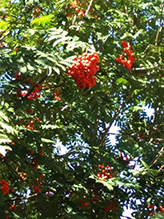 |
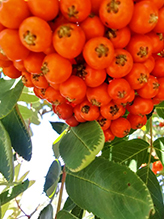 |
|
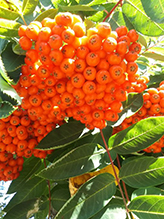 |
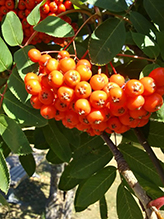 |
|
MinnesotaSeasons.com Photos |
||
|
||
|
||

Visitor Videos |
||
Share your video of this plant. |
||
This button not working for you? |
||
|
Other Videos |
||
Zack and Showy Mountain Ash |
About
Jul 12, 2024 Zack gives the facts on another Minnesota native tree that wildlife love and explains why there's no need to be concerned about EAB with this species. |
@toto Talomo |
About
Oct 16, 2021 Walking around and came across with this orange berries like fruit tree. Sorbus decora, commonly known as the northern mountain ash, showy mountain-ash, or dogberry, is a deciduous shrub or very small tree native to northeastern North America.looks really beautiful that’s why I shared this. Thanks for watching |

|
Created: 1/14/2025 Last Updated: © MinnesotaSeasons.com. All rights reserved. |
